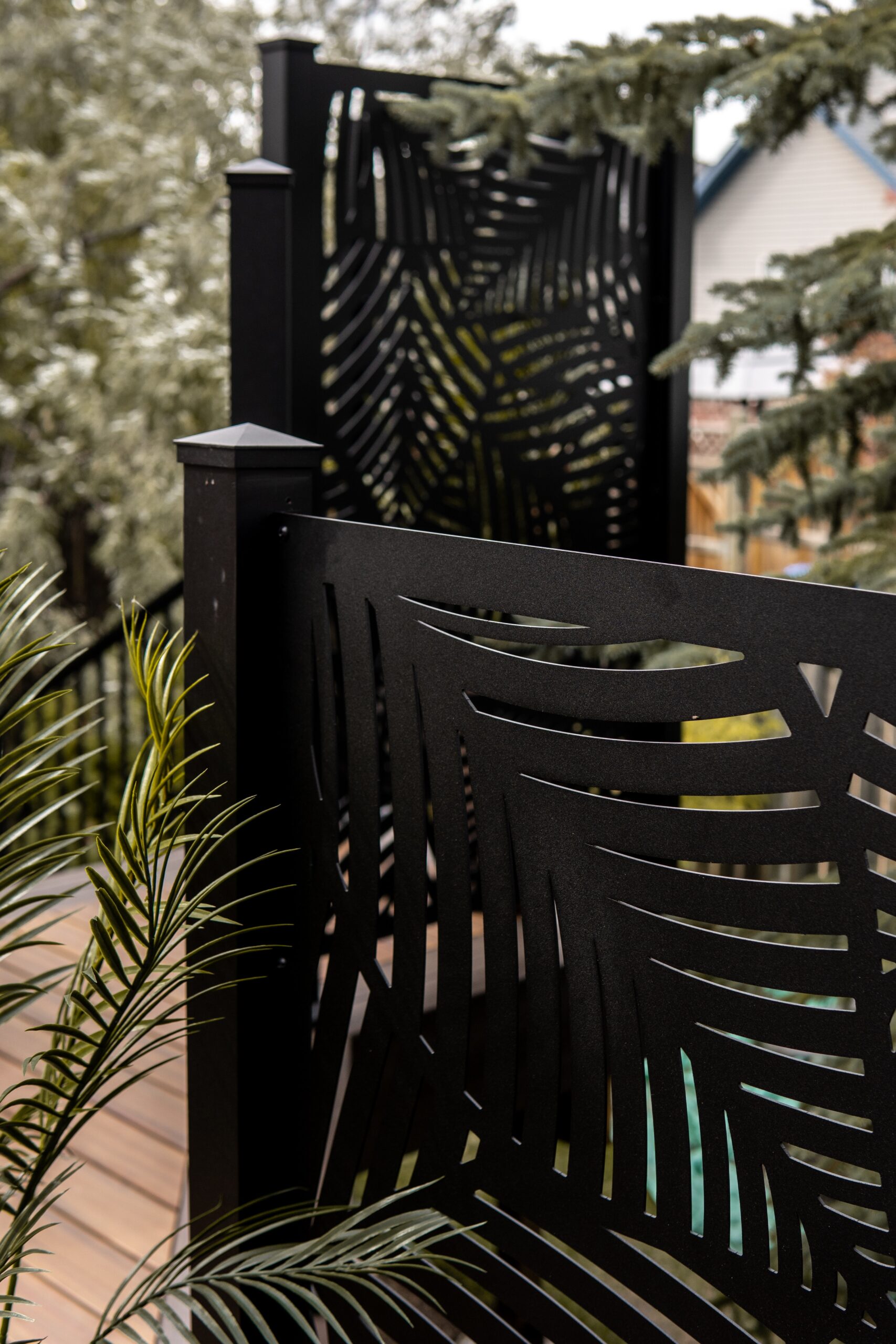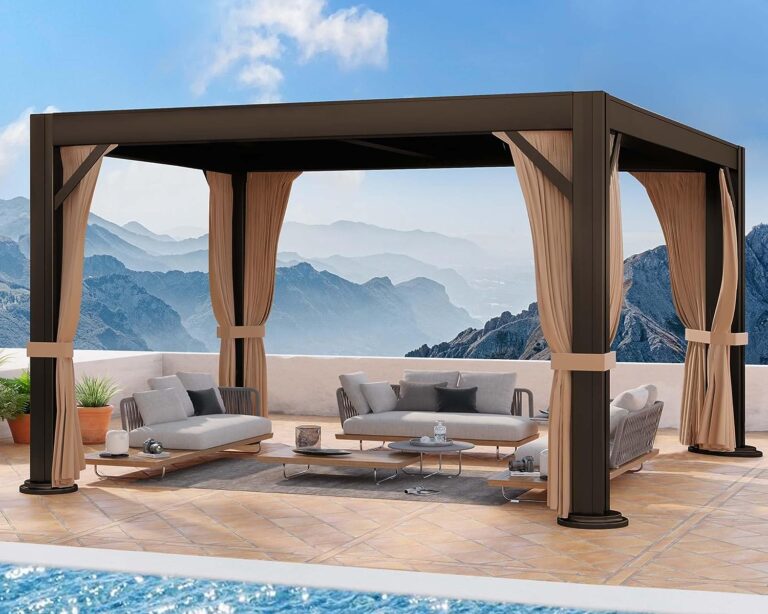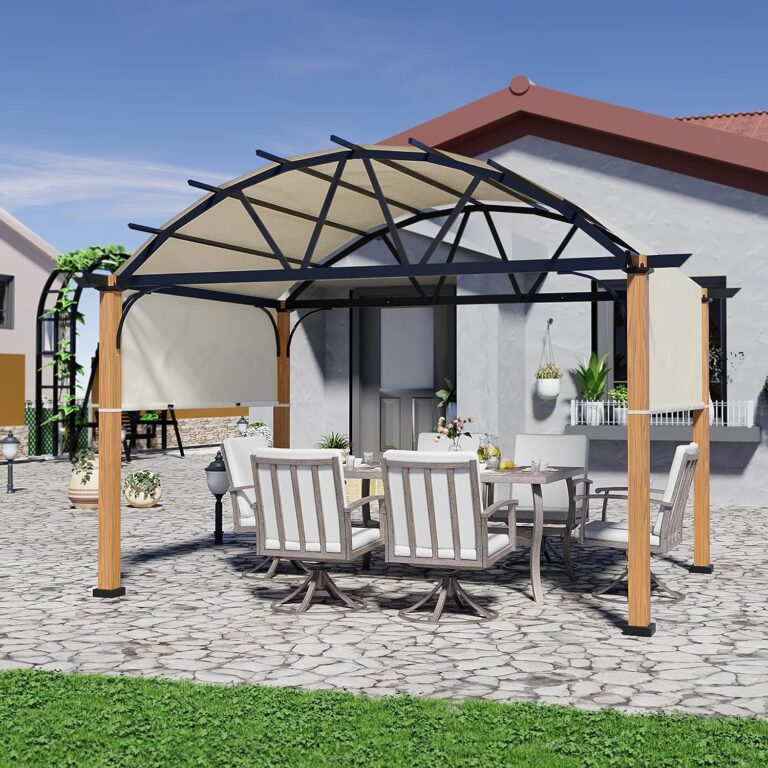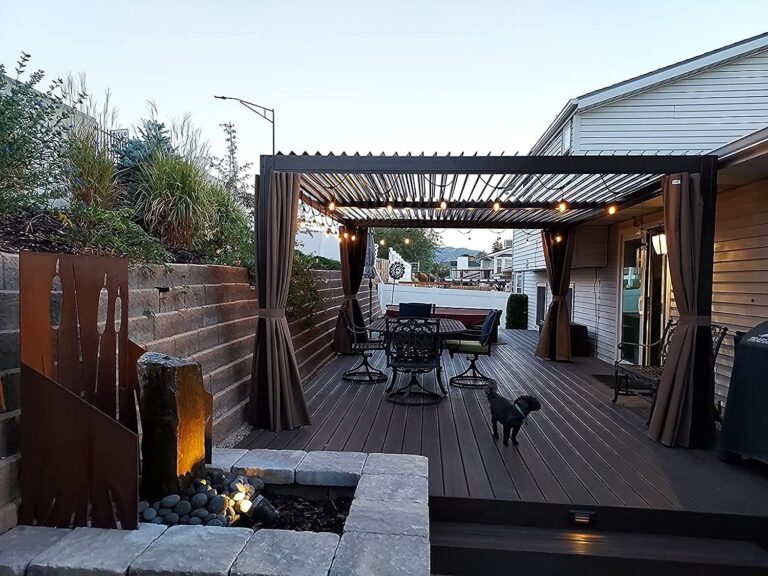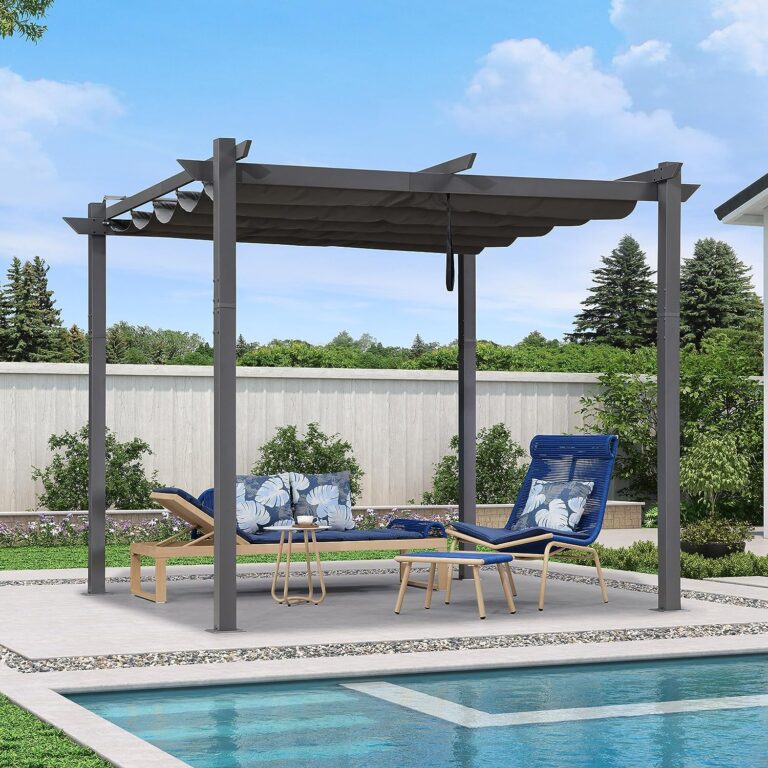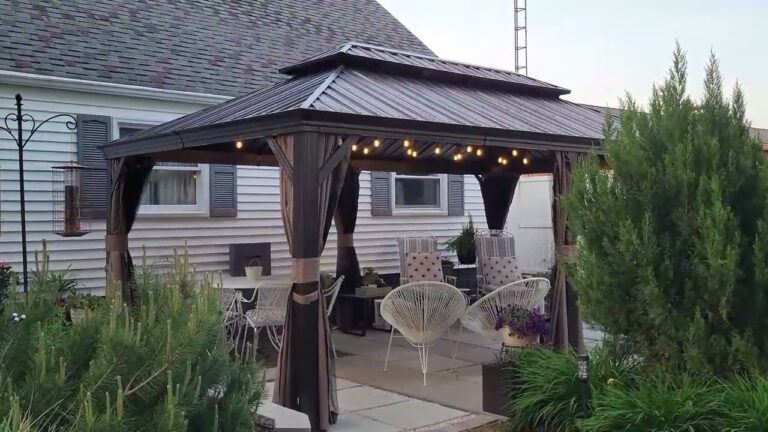Finding the Best Pergola Materials for Your Space
Choosing the right material is crucial to create a stunning outdoor space with a pergola. This article will guide you through finding the best material for your pergola space. Whether you seek durability, aesthetics, or low maintenance, we’ve got you covered. Join us as we explore the various options and help you decide on your perfect pergola retreat.
Understanding Pergola Materials
A pergola can be a wonderful addition when creating a beautiful outdoor space. A pergola is a structure with an open framework and a roof-like canopy, providing a comfortable and stylish space for relaxation and entertaining. However, choosing the right pergola materials ensures durability, longevity, and aesthetics. This comprehensive guide will delve into the different types of pergola materials, evaluate their pros and cons, and explore crucial factors to consider when deciding. By the end, you will be fully equipped to select the perfect material for your pergola that suits your preferences, complements your home, and withstands various weather conditions.
Defining a Pergola
Before diving into the world of pergola materials, let’s define a pergola. A pergola is a unique outdoor structure typically consisting of vertical posts, supporting crossbeams, and an open roof structure. Unlike a fully covered patio or a gazebo, a pergola offers partial shade and an airy, open feel. It often extends a home’s living space, providing a designated area for outdoor dining, lounging, or growing climbing plants. With its versatility and ability to transform any outdoor area, a pergola can greatly enhance your outdoor space’s aesthetic appeal and functionality.
The Role of Pergola Materials
Choosing pergola materials is crucial in determining your pergola’s overall look, durability, and maintenance requirements. Different materials offer varying degrees of strength, resistance to weather conditions, and aesthetics. From classic options like wood and metal to modern alternatives like vinyl and fiberglass, each material brings advantages and disadvantages. By understanding the characteristics and properties of various pergola materials, you can make an informed decision that aligns with your needs and preferences.

Factors to Consider when Choosing Pergola Materials
Several important factors must be considered before delving into the specific types of pergola materials. These factors will help guide your decision-making process and ensure you select a pergola material that best suits your needs. Here are some key points to consider:
- Budget: Consider your budget and determine how much you will invest in your pergola. Different materials come at various price points, and balancing cost with quality and longevity is important.
- Aesthetics: Think about the overall look and style you want to achieve with your pergola. Consider the architectural style of your home and choose a material that complements it seamlessly. Whether you prefer a rustic wooden pergola or a sleek, modern metal structure, the material you choose should enhance the visual appeal of your outdoor space.
- Durability: Assess the weather conditions and climate in your area. Some materials are more resistant to harsh weather elements like rain, wind, and UV rays than others. Choosing a material that can withstand the local climate will ensure that your pergola remains in good condition for many years.
- Maintenance: Consider how much time and effort you are willing to dedicate to maintaining your pergola. Some materials require regular maintenance, such as staining or painting, while others are virtually maintenance-free. Evaluate your willingness to invest time and energy into upkeep to determine the appropriate material for your needs.
Considering these factors, you can narrow down your options and make an informed decision when selecting the right pergola material for your outdoor space.
Wooden Pergolas
Wooden pergolas have long been popular among homeowners due to their timeless beauty and natural appeal. With a wide range of wood options available, there is a wood type to suit every taste and budget.
Types of Wood Used
When it comes to wooden pergolas, several types of wood are commonly used. Cedar, redwood, and pressure-treated pine are among the popular choices. Cedar is highly regarded for its natural resistance to decay, insects, and rot. Redwood offers similar attributes to cedar, with its beautiful color and durability. Pressure-treated pine is an economical option that has been treated with chemicals to increase its resistance to rot and insects.
Benefits of Wood as Pergola Material
One of the main advantages of wood as a pergola material is its aesthetic appeal. Wood exudes warmth, elegance, and a natural charm that can enhance any outdoor space. It can be stained or painted in various colors to match your home’s exterior or create a unique focal point in your yard. Additionally, wood is relatively easy to work with, allowing for customization and personalization to fit your specific design preferences.
Drawbacks of Wood Pergolas
While wood is a popular choice, it’s also important to consider its drawbacks. Wood requires regular maintenance to preserve its quality and appearance. It needs staining or sealing every few years to protect it from weathering and to prevent rotting. Additionally, wood is susceptible to insect infestations, particularly if not properly maintained. This means regular inspections and treatments may be necessary to keep pests at bay.
Maintenance and Care for Wooden Pergolas
Maintaining a wooden pergola involves regular cleaning, staining, and sealing. To ensure the longevity of your wooden structure, it is recommended to clean it at least once a year to remove dirt, debris, and mold. Staining or sealing is typically required every two to three years, depending on the climate. Regular insect damage inspections and promptly addressing any issues will help extend your wooden pergola’s lifespan. By following these maintenance practices, you can enjoy the beauty and durability of your wooden pergola for many years.

Vinyl Pergolas
If you want a low-maintenance and durable option, vinyl pergolas may be perfect. Vinyl, also known as polyvinyl chloride (PVC), is a synthetic material that has gained popularity recently for its versatility and long-lasting nature.
Pros of Using Vinyl
One of the biggest advantages of vinyl pergolas is their resistance to the elements. Vinyl is highly durable and can withstand extreme weather conditions, including heavy rain, intense sunlight, and strong winds, without fading or warping. Unlike wood, vinyl does not require staining, sealing, or painting, making it virtually maintenance-free. It can be easily cleaned with soap and water, keeping it pristine with minimal effort. Additionally, vinyl is available in various colors and styles, allowing for customization and flexibility in design.
Cons of Vinyl Pergolas
While vinyl pergolas have numerous benefits, they have a few drawbacks. One such drawback is the limited design options compared to other materials. Vinyl has a uniform, synthetic appearance that may not appeal to those seeking a more natural or traditional aesthetic. Additionally, vinyl can be more expensive than wood or metal initially, although the lack of maintenance costs can offset this in the long run. Finally, while vinyl is highly durable, it can be prone to cracking or damage from impact, so it’s important to handle it carefully.
Caring for Vinyl Pergolas
Keeping a vinyl pergola in top shape requires minimal effort. Regular cleaning with simple soap and water is usually sufficient to remove dirt or stains. To avoid damage, it’s important to use gentle cleaning materials and avoid abrasive cleaners or brushes that could scratch the surface of the vinyl. Inspecting the structure periodically for any cracks or damage and addressing them promptly will ensure the longevity and beauty of your vinyl pergola.
Cost of Vinyl Pergolas Compared to Other Materials
Vinyl pergolas generally have a higher upfront cost compared to wood or metal. However, vinyl can be a cost-effective option in the long run when considering the lifespan and maintenance requirements. With minimal maintenance needs and exceptional durability, vinyl pergolas can provide an excellent return on investment. Assessing your budget and weighing the long-term benefits can help you determine whether a vinyl pergola is the right choice.
Metal Pergolas
Metal pergolas offer a contemporary and sleek option for those seeking a modern aesthetic. Whether you prefer steel’s industrial look or wrought iron’s elegance, metal pergolas can add a touch of sophistication to your outdoor space.
Types of Metal Used
Several types of metal are commonly used for pergolas, each with unique characteristics. Steel is a popular choice for its strength and durability. When properly treated, it can withstand heavy loads and is resistant to rust and corrosion. Aluminum is lightweight, making it easy to install and highly resistant to rust. Wrought iron is known for its timeless appeal, intricate designs, and durability.
Advantages of Metal Pergolas
One of the main advantages of metal pergolas is their strength and durability. Metal structures can withstand strong winds, heavy snow loads, and other severe weather conditions. Unlike wood, metal is not prone to rotting or insect damage, reducing the need for regular maintenance. Metal pergolas also offer various design possibilities, from sleek and minimalist to ornate and decorative. Their clean lines and contemporary look make them popular for modern outdoor spaces.
Disadvantages of Metal Pergolas
Despite their many benefits, metal pergolas do have a few drawbacks. One such drawback is their susceptibility to heat and sun exposure. Metal can become hot to the touch under direct sunlight, potentially making the space underneath uncomfortable during peak sun hours. To mitigate this, add shade sails or fabric canopies to create additional protection and shade. Additionally, metal pergolas can be more expensive than other materials, depending on the specific type of metal chosen.
Maintaining Metal Pergolas
Maintaining a metal pergola typically involves periodic cleaning to remove dirt, dust, and other debris. It’s important to inspect the metal structure regularly for signs of rust or corrosion and address any issues promptly to prevent further damage. Applying a protective coating or paint can help prolong the lifespan of a metal pergola and enhance its appearance. Following the manufacturer’s guidelines for maintenance and care will ensure that your metal pergola remains in excellent condition for years to come.

Fiberglass Pergolas
Fiberglass pergolas offer an excellent alternative for lightweight and versatile options. Fiberglass is a composite material made from glass fibers and polymer resin, resulting in a strong and durable structure.
Benefits of Fiberglass Material
One of the main benefits of fiberglass as a pergola material is its lightweight nature. Fiberglass pergolas are easy to handle and install, making them a popular choice for do-it-yourself enthusiasts. Despite its lightweight, fiberglass is highly durable and resistant to extreme weather conditions, including high winds and strong sunlight. It can be molded into various shapes and sizes, creating unique and creative designs. Fiberglass is also non-porous, meaning it does not absorb moisture or require sealing, making it virtually maintenance-free.
Drawbacks of Fiberglass Pergolas
While fiberglass has numerous advantages, it does have a few drawbacks. Fiberglass has a sleek and modern appearance, which may not appeal to those seeking a more traditional or rustic look. Additionally, fiberglass pergolas may have limited color options compared to other materials. Over time, fiberglass may experience fading or discoloration due to prolonged sun exposure, so choosing high-quality fiberglass and considering adding a protective UV-resistant coating or paint is important.
Fiberglass Pergola Maintenance
Maintaining a fiberglass pergola requires minimal effort. Regular cleaning with soap and water is usually sufficient to keep it looking clean and fresh. Avoid using abrasive cleaners or rough brushes that could scratch the surface of the fiberglass. Inspecting the structure periodically for any signs of damage or wear is essential, as prompt repairs can prevent further issues. By following these simple maintenance practices, you can ensure the longevity and beauty of your fiberglass pergola.
Cost Comparison of Fiberglass to Other Materials
The cost of fiberglass pergolas can vary depending on size, design, and additional features. Fiberglass tends to be more affordable than materials like wood or metal, making it an attractive option for those on a budget. Its low maintenance needs and durability also contribute to its cost-effectiveness in the long run. Evaluating your budget and considering the specific requirements of your outdoor space will help determine whether a fiberglass pergola is the right choice for you.
Stone or Brick Pergolas
For a timeless and sturdy option, stone or brick pergolas offer durability and unmatched elegance. Stone and brick pergolas can add a touch of classical charm and sophistication to any outdoor space.
Strengths of Stone and Brick Pergolas
One of the main strengths of stone and brick pergolas is their durability. Stone and brick are natural materials that can withstand the test of time, making them ideal for long-lasting structures. They can easily withstand extreme weather conditions, including heavy rain, winds, and earthquakes. Additionally, stone and brick offer a classic and elegant appearance that can enhance the overall aesthetic of your outdoor space. Their inherent strength and stability make them an excellent choice for a robust and luxurious pergola.
Weaknesses of These Types
While stone and brick pergolas offer numerous advantages, they have a few weaknesses. One prominent drawback is their high cost. Stone and brick materials are more expensive upfront than other options. Additionally, the weight of stone and brick can be substantial, requiring proper structural support during installation. It’s important to consult with professionals to ensure that the foundation and structure can adequately handle the weight of these materials. Lastly, stone and brick pergolas can be time-consuming due to the precise placement and intricate masonry work required.
Caring for Stone and Brick Pergolas
Caring for stone and brick pergolas is relatively straightforward. Regular cleaning with a mild detergent and water is usually enough to keep them looking their best. It’s important to avoid using abrasive cleaners or tools that could cause scratches on the surface. Periodic inspections for any signs of cracking or damage are essential, and any issues should be addressed promptly. With proper care and maintenance, a stone or brick pergola can remain a stunning centerpiece in your outdoor space for generations.
Comparative Costs of Stone and Brick Pergolas
Stone and brick pergolas tend to be more expensive than other materials, largely due to the cost of the raw materials and the labor-intensive construction process. The specific cost will depend on factors such as the type of stone or brick chosen, the size and complexity of the design, and local labor costs. It’s important to assess your budget and consider the long-term benefits and aesthetic appeal when deciding whether a stone or brick pergola is the right choice for your outdoor space.
Composite Material Pergolas
Composite materials have gained popularity recently due to their durability, versatility, and eco-friendliness. A composite material pergola combines different elements to create a structure that offers the best of both worlds.
Benefits of Composite Materials
One of the main benefits of composite material pergolas is their longevity and resistance to weathering. Composite materials are engineered to be highly durable and to withstand various weather conditions without warping, peeling, or fading. They are also resistant to rot, insects, and decay, eliminating the need for regular maintenance such as staining or sealing. Composite materials are available in various colors and styles, allowing you to achieve the desired look for your outdoor space.
Disadvantages of Composite Pergolas
While composite pergolas have numerous advantages, they have a few drawbacks. One such drawback is the initial cost, as composite materials can be more expensive than traditional options like wood or metal. However, the lack of maintenance costs and the extended lifespan can offset this initial investment. Additionally, composite materials may have a synthetic appearance that may not appeal to those seeking a more natural or traditional aesthetic. It’s important to choose a high-quality composite material that closely emulates the look and feel of natural wood for a more authentic appearance.
Composite Material Maintenance
Maintaining a composite material pergola is relatively easy. Regular cleaning with soap and water is usually sufficient to remove dirt and debris. Avoid using abrasive cleaners or rough tools that could damage the surface of the composite material. Since composite materials resist rot and decay, they do not require staining, sealing, or painting. Periodic inspections for any signs of damage or wear are recommended, and addressing any issues promptly will help ensure the longevity and appearance of your composite material pergola.
Cost Analysis of Composite Material Pergolas
The initial cost of a composite material pergola can be higher than other materials. However, the lack of maintenance requirements and the exceptional durability of composite materials can make them a cost-effective option in the long run. Assessing your budget, evaluating the specific requirements of your outdoor space, and considering the benefits of composite materials will help you determine whether a composite material pergola is the right choice for you.
Resilience to Weather Conditions
One crucial factor to consider when choosing a pergola material is its resilience to weather conditions. Depending on your location and climate, different materials may be better suited to withstand the elements and ensure the longevity of your pergola.
How Different Materials Withstand Different Climates
Wood is a versatile material that can withstand various climates but may require regular maintenance in humid or rainy regions. Vinyl is highly resistant to moisture, making it an excellent choice for damp climates. Metal, such as steel or aluminum, is durable and can handle extreme weather conditions like heavy snow loads or intense heat. However, metal pergolas may require additional measures to deal with heat retention. Fiberglass is highly resistant to weathering and is suitable for areas with high winds or intense sunlight. Stone and brick pergolas are naturally strong and can withstand almost any weather condition, making them a great choice for areas prone to hurricanes or earthquakes. Composite materials offer exceptional resistance to moisture, heat, and UV rays, making them suitable for various climates.
Protecting Your Pergola from Weather Damage
While selecting a material that can withstand weather conditions is important, taking certain measures to protect your pergola can further enhance its durability. Adding a weather-resistant sealant or paint to wood can protect against moisture and prolong its lifespan. Installing shade sails, retractable canopies, or pergola curtains can shield your pergola and the surrounding area from intense sunlight, ensuring comfortable outdoor experiences. Regular inspections and prompt repairs can help prevent minor issues from escalating into major problems, ultimately preserving the integrity of your pergola.
Chosen Material’s Impact on Longevity
The material chosen for your pergola can significantly impact its longevity. Materials like vinyl, metal, fiberglass, stone, and composite tend to have longer lifespans due to their resistance to weather conditions and rotting. Wood pergolas can have varying lifespans depending on the type of wood used and the level of maintenance provided. With proper care, regular inspections, and prompt repairs, your pergola can provide an inviting outdoor oasis for many years, regardless of the chosen material.
Sustainability of Pergola Materials
As environmental concerns continue to grow, many homeowners seek pergola materials that are eco-friendly and sustainable. Choosing materials that have minimal environmental impact can contribute to a more sustainable and responsible outdoor space.
Eco-Friendly Material Options
Several eco-friendly options are available for pergola materials. These include sustainably sourced wood options such as FSC-certified lumber or reclaimed wood. Vinyl materials can be selected from manufacturers that incorporate recycled materials or offer recycling programs for their products. Composite materials often include a percentage of recycled materials, reducing the need for virgin resources. Exploring these eco-friendly alternatives allows you to enjoy your outdoor space without compromising the environment.
Recycled Material Pergolas
Pergolas made from recycled materials offer a sustainable option for conscious homeowners. Recycled plastic or composite materials can be used to create pergolas that mimic the appearance of traditional materials like wood or metal. These materials reduce landfill waste, require minimal maintenance, and resist rot and decay. By choosing a pergola made from recycled materials, you can contribute to a more sustainable future while enjoying the beauty and functionality of your outdoor space.
Impact of Material Manufacturing on the Environment
Considering the impact of material manufacturing is essential when choosing a pergola material. Materials that require excessive energy consumption or release harmful byproducts during manufacturing processes can hurt the environment. Opting for materials that use sustainable manufacturing practices, minimize energy usage, and reduce greenhouse gas emissions can contribute to a more environmentally friendly choice. By selecting responsibly manufactured materials, you can create an outdoor space that aligns with your eco-conscious values.
Final Considerations in Choosing Pergola Material
After exploring the various types of pergola materials and considering the factors that influence your decision, there are a few final considerations to remember when choosing the perfect material for your pergola.
Matching Pergola Material to Home Exterior
Harmonizing your pergola material with the exterior of your home can create a seamless and cohesive look. Consider the architectural style, color palette, and materials used in your home’s exterior when selecting your pergola material. Whether you choose a material that complements or contrasts with your home, ensuring a harmonious overall appearance will enhance the visual appeal of your outdoor space.
Assessing Installation Complexity
Different pergola materials may require varying levels of installation complexity. Some materials, like vinyl or fiberglass, are lightweight and easy to handle, making them ideal for DIY installation projects. Others, such as stone or brick, may require professional assistance due to their weight and intricate installation process. Consider your level of expertise, available tools, and comfort with DIY projects when choosing a material that aligns with your installation capabilities.
Balancing Aesthetics and Functionality
The balance between aesthetics and functionality is crucial when selecting a pergola material. While aesthetics play a significant role, it’s important not to overlook the functional aspects. Consider factors such as the amount of shade desired, the openness of the structure, and the ability to grow climbing plants when selecting a material. Balancing the visual appeal with the practicality of your pergola will ensure that it becomes a truly functional and enjoyable addition to your outdoor space.
Personal Preference and Lifestyle Requirements
Ultimately, your personal preference and lifestyle requirements should guide your choice of pergola material. Consider the overall vibe and ambiance you want to create in your outdoor space and how you plan to use the pergola. If you prioritize a natural and rustic look, then wood or stone may be your best option.
If low maintenance and durability are your main concerns, then vinyl or metal might be more suitable. By aligning your personal preferences and lifestyle requirements with the chosen material, you can create a pergola that truly reflects your unique style and meets your needs.
In conclusion, choosing the right pergola material is crucial in creating a beautiful, durable, and functional outdoor space. By understanding the characteristics, benefits, and drawbacks of various materials, you can make an informed decision that suits your preferences, complements your home, and withstands different weather conditions. Considering budget, aesthetics, durability, maintenance, and sustainability will guide you in selecting the perfect material for your pergola.
Remember to assess the impact on longevity, consider the resilience to weather conditions, and select materials that align with your eco-conscious values. With careful consideration and proper care, your pergola will become a cherished addition to your outdoor space, providing endless opportunities for relaxation, entertainment, and enjoyment for years to come.
